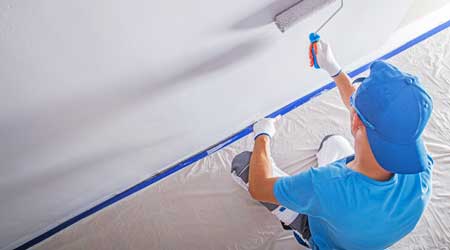 Managers who understand the importance of ensuring that workers perform effective surface preparation are more likely to produce applications that deliver long-term performance.
Managers who understand the importance of ensuring that workers perform effective surface preparation are more likely to produce applications that deliver long-term performance.Paints and Coatings Applications for Long-Term Performance
Manufacturers offer insights on effective surface preparation and selecting paints to meet surface needs
Proper surface preparation will only pay dividends if managers specify paints and coatings that will adhere to the surface in the face of wear and tear after application.
“Today, our advanced coatings are specially formulated to go on smoothly to help workers avoid brush marks, roller marks and spattering,” Watson says. “These types of features can help make pre-painting surface preparation easier because quality paint starts with quality raw materials. There are newer finish coatings on the market that help block stains from coming through the finish. These coatings block against grease, grime, food and cigarette smoke stains and are ideal for multifamily units and facility maintenance.
Morris points to new-generation products that contain fewer volatile organic compounds (VOC).
“With the new low-VOC products and high-solids products, the anchor profile is as important as cleanliness,” he says. “These advanced coatings do not ‘wet out the surface’ as solvent- or water-based coatings have for decades. They require a highly profiled, angular surface to mechanically adhere to the substrate.”
Successful paint and coating selection also depends greatly on the type of substrate to which workers will apply the product. Watson offers these substrate-specific guidelines:
Fiber-cement. “If improperly treated, cement-based products can be difficult to coat, especially if the pH is high, the boards are chalky or the surface is wet. Look for a high-quality exterior acrylic masonry primer that is able to withstand pH levels to 13 and is efflorescence-resistant.”
Cedar and redwood. “A primer is essential for cedar and redwood shake or siding because it will serve as a barrier to prevent the bleed of tannin, a colored wood extract that can appear on painted wooden surfaces. However, if applied to these bare woods, there are coatings that may show some staining with the first coat in which the tannin can be trapped. A second coat will make the appearance uniform.”
Vinyl. “If the surface of the vinyl remains slick and ultra-smooth after it has been cleaned with a detergent, opt for a bonding primer to achieve quality results. Follow all painting guidelines from the vinyl manufacturer when painting and only paint properly installed vinyl siding. Deviating from the manufacturer’s painting guidelines may void the warranty.”
Stucco and masonry. “Since pH levels can be a concern with new stucco, make sure the primer can be applied to surfaces with a high pH level. This will minimize alkali and efflorescence problems later on. Look for coatings that are specifically designed to be applied directly to concrete and masonry surfaces. These coatings often offer better alkali and efflorescence resistance, wind-driven rain resistance and can be applied directly to fresh concrete that is at least seven days old.”
Surface preparation and paint and coating specification can be a complex process, given the variety of materials involved. Manufacturers can provide managers with guidance for their specific situations.
“Managers should rely on a knowledgeable coatings professional who understands the coating and the substrate being coated,” Morris says. “A coatings professional can help managers understand which products to use on metal, wood, masonry, and other substrates, as the coating technology can differ significantly based on the substrate and other factors.”
In cases where another set of eyes is required, managers can turn to manufacturer representatives for assistance.
“Field representatives along with a network of independent retailers are willing to conduct free facility assessments,” Mundwiller says. “This service network can provide the best recommendation for products for a particular substrate, including qualifying the exposure to which the coatings system will be subjected to.”
Related Topics:














